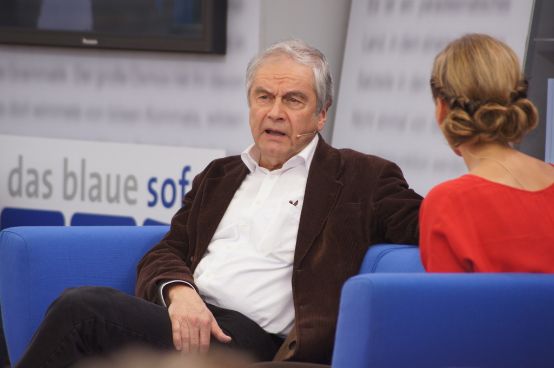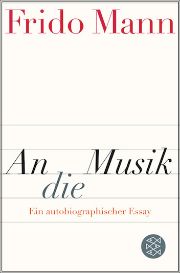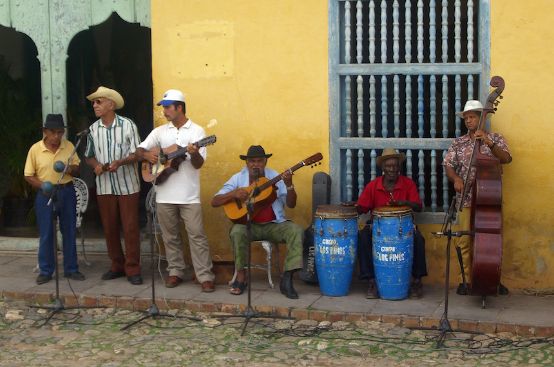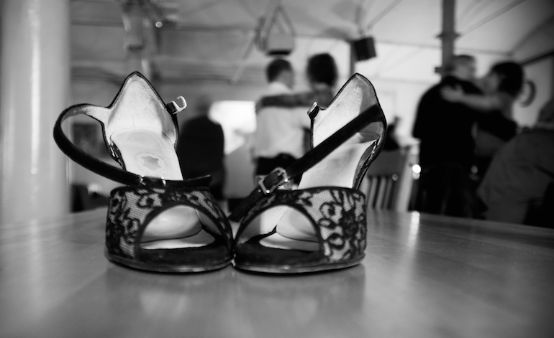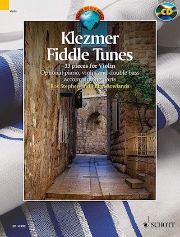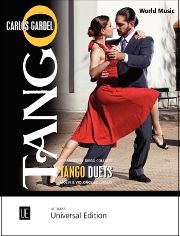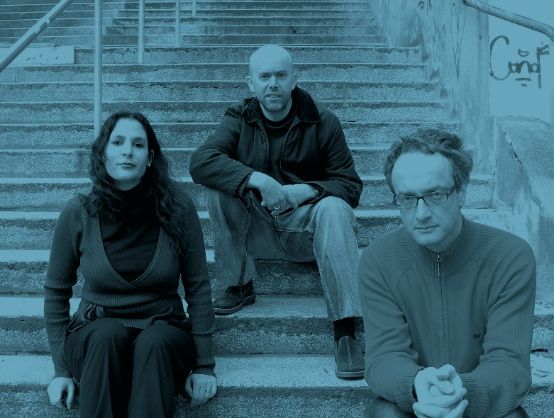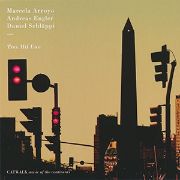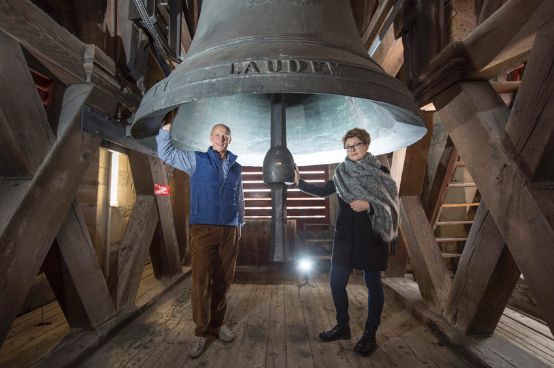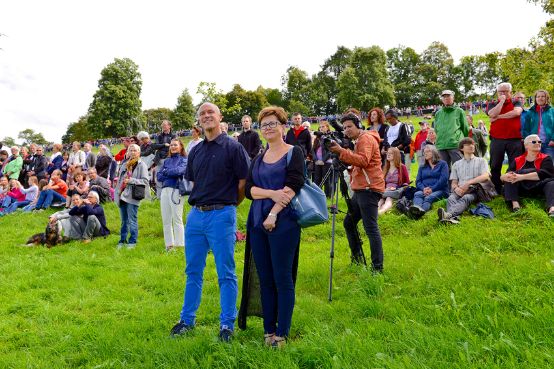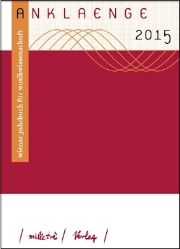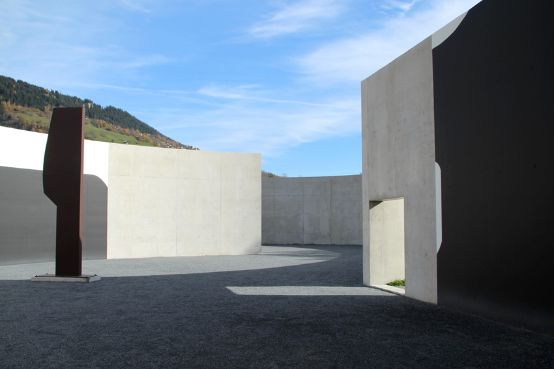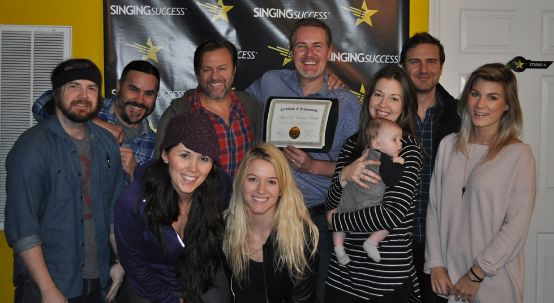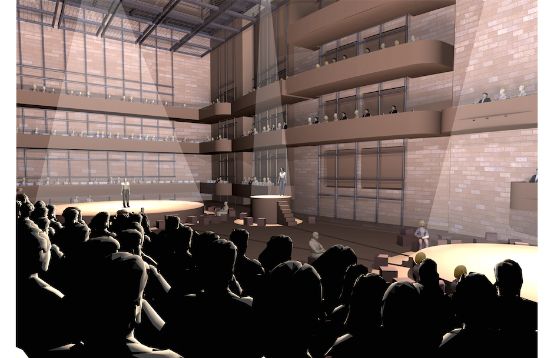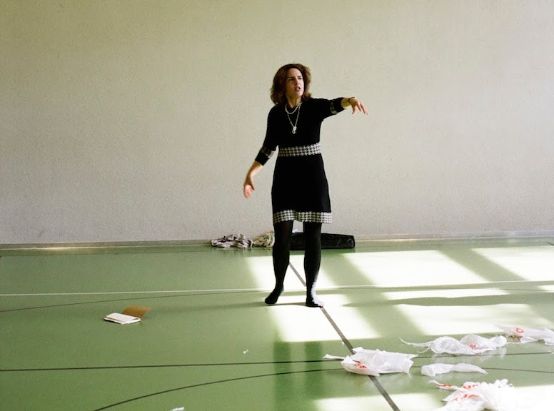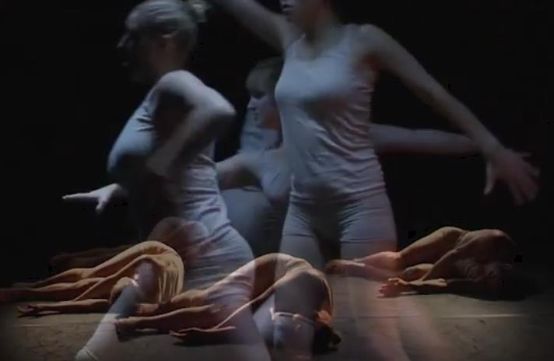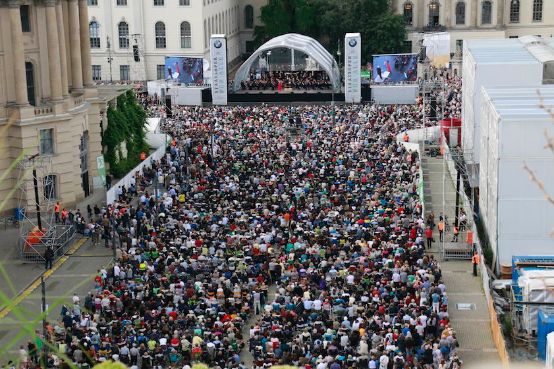After 15 years of teaching at the Kantonsschule am Burggraben in St. Gallen, I was granted a six-month sabbatical. It enabled me to learn the world's most successful systematic pop vocal system in Nashville and to work as a licensed vocal coach.
Brett Manning is the inventor of the Singing Success system. His outstanding position is explained by the fact that, as Edison so aptly put it, he "stands on the shoulders of the giants of the past". He draws on the Italian classical bel canto singing technique of Luciano Pavarotti, the speech-level singing technique of Seth Riggs and many other researches and experiences.
Singing Succes compared to other techniques
Classical bel canto voice formation works with a low larynx position and a large dome resonance as well as a support, which combined with the singer's formant (increased overtone range at 3500 Hz) leads to a very sustainable, expressive, balanced and break-free voice that can even drown out an orchestra "sounding beautiful". Interestingly, it is based on William Tellon the role of Arnold in Rossini's opera. Gilbert Duprez sang the "Do di petto", the high c2 (C5), in full "tenore di forza" chest voice for the first time in 1837. He was the first master of the mixed voice, even if he didn't call it that. He initially studied in the "old" school of nasal, lighter French opera, before moving on to Italy, where he implemented the southern power and body-emphasized voice and bel canto. This led to the greatest vocal revolution in the history of singing. Tragically, the head voices such as Adolphe Nourrit of the old French (partly baroque, castrato-oriented) school of singing were suddenly out of work. Rossini himself winkingly and ironically called the sound the "death cry of a capon" (castrated cock). To this day, this technique is the measure of all things, taught at all opera schools and masterfully mastered by Luciano Pavarotti, who is a very important source for the singing-success technique.
In Germany, the bel canto technique was further developed by lowering the larynx position and increasing the resonance and breath support. This resulted in very dark, dramatic, heavy, loud, metallic voices that were able to withstand the extreme volume of the orchestra in Richard Wagner's late romantic music dramas.
The bel canto technique found a different path in French Impressionism. The larynx was set a little higher, the voice became lighter and more agile, more ornately "perfumed" and the resonance shifted mainly towards nasality. The French language has many nasal sounds, which were also used extensively by popular singers such as Edith Piaf.
Speech-level singing by Seth Riggs (a teacher of Brett Manning) is one of the best-known modern pop vocal techniques. It pays less attention to the edges of the vocal folds and activates the mixed voice primarily through the pharyngeal resonator (palatal resonance sound).
Musical voice training (e.g. Natalie Weiss or Jo(sephine) Estill) uses the so-called belting technique, which sometimes uses too high a chest voice function and usually a high larynx position.
Ken Tamplin's Open Throat Technique is mainly based on the very open, internally broad singing style of a single coach without a systematic approach and is therefore very one-sided.
According to Catherine Sadolin from Copenhagen, the Complete Vocal Technique is based on scientific research and comprises (according to Wikipedia): three basic principles (support, twang, and avoiding lips or jaw tension), four modes (neutral, cranking, overdrive and edge), timbres (light and dark) and effects (distortion, vibrato, screams, embellishments, etc.). In my experience, it is aimed more at advanced singers who are looking for a new perspective for their vocal training.
As interesting as these aspects may seem, the voice is more fascinating because of its emotional programming and less because of its cognitive scientific nature. I would even say that the voice can actually only be addressed and programmed emotionally.
The functional voice training of Cornelius Reid (with whom I took lessons in a master class in Munich) also emphasizes the muscular, scientific approach. The question of which muscle or muscle group is responsible for which vocal function is interesting, but fails to recognize that the voice usually has to be activated emotionally in order to touch the audience emotionally.
The Alexander Technique, developed by Shakespearean actor Frederick Alexander, was initially aimed at the speaking voice and works mainly with physical exercises to avoid incorrect tension and unfavorable habits. It is often used in addition to a singing technique (e.g. also at the Munich Academy of Music).
The technique of the Singing Success System
For me, the most comprehensive, systematic and effective singing technique, the Singing Success System, uses some of the above-mentioned techniques, adds many new principles, combines them, organizes them and leads to vocal success as quickly as possible. Through systematic exercises, the voice almost reaches the range of a piano keyboard. Brett Manning demonstrates an incredible vocal range of six octaves on YouTube and live in the studio every day. No coach of the above-mentioned techniques can achieve this. Manning is the first male voice to master the snare register in the low register and the whistle register in the high register to such an extent that he can reach notes an octave higher than the famous high C of the highest female voice (soprano) and more than an octave lower than the low C of the lowest bass voice.
Here is the quintessence in a nutshell:
The four cornerstones in the teaching of Singing-Success are
1. LOVE
... and genuine interest are the most important basis
2. SELF-CONFIDENCE
... we develop through support and expertise
3. VOCAL TECHNIQUE
... activates vocal skills
4. LISTEN
... means paying attention to all aspects of personality
The three most important principles of this technique are
1. inform the MIND: understanding for the cerebral type of learner
2 Acclimate the EAR: Hearing the right sound for the auditory learning type
3 Coordinate the VOICE: Coordinating the voice for the experimental learner type
all three in EQUAL ULTIMACY: All three principles should be used in equal completion.
The acronym "T-E-M-P-S" describes the five most important components of singing
Technical (vocal technique)
Emotional (feelings)
Mental (thoughts)
Physiological (body)
Spiritual (Spiritual)
Important principles here are:
"Light and right - not strong and wrong"
"First speak it - then sing it"
"You rather catch it - than you teach it"
The TEMPS components are discussed individually in five lessons as part of the training; the three foundations, three principles and three coach characteristics in six further lessons. At this point, only one special description should be mentioned: It is recommended to connect the two hemispheres of the brain by listening to J. S. Bach's Air and activating the corpus callosum (brain beam). Eye movements to the left and right with closed eyelids support the connecting effect of music with regard to the activities of the emotional-right and rational-left hemispheres of the brain.
However, the most important goal of this singing technique is the so-called mixed voice. The most difficult transition (called a passaggio or bridge) to achieve a wide vocal range is at the upper end of the chest voice:
In a bass voice it is around cl.a, cl.b or cl.b; in tenors and altos it is around e1, f1 or f sharp1 and in sopranos the chest voice usually ends at the concert pitch a1, b1 or b1.
In order to make this transition, the support, i.e. the breath pressure, is usually activated in classical music in order to support the vocal folds in their ability to stretch for higher notes and to strengthen the muscles. In the Singing Success system, there are three new strategies for singing higher:
1. thin out vocal folds, reduce pressure and weight
2. resonance and vocal fold coordination are used with the help of the nasal pharyngeal resonator when switching to the next gear (to the head voice register).
3rd Damping of the vocal folds. At the upper end of the chest voice, the stretching vocal fold muscles are gradually combined with the compressing muscles, resulting in fewer and fewer vocal folds (shortening to approx. 1/3) vibrating as the pitch increases, like a zipper, and thus producing higher notes. This results in the so-called mixed voice, which mixes the head and chest voice. Singing students are advised not to think too much about it, but to "catch" the technique for themselves by imitating the singing exercises.
Lesson structure
At the beginning of the lessons, students are encouraged to always record their learning steps acoustically, e.g. on their cell phone, so that they can repeat them daily at home as a practice guide. There is no other singing technique in the world with so many freely available YouTube videos on every conceivable vocal problem. In addition, over 100 exercises are systematically recorded on 7 technique CDs of the Singing Success 360™ system. This basis is supplemented by 7 style CDs, the CDs Mastering Mix, the videos and recordings of Mastering Harmony and Mastering vibrato. There are also 3 DVDs with the Top 7 Exercises by Dave Brooks, Jessie Nemitz and Brett Manning as well as a huge archive of lessons on Singing Success TV for subscribers. This means that every student can systematically practise the singing principles alongside the singing lessons with CD aids.
Here is a very brief description of the exercises and the typical course of a lesson.
1. welcome
Questions about state of mind, honest, interested small talk, projects
2. warm up
Sums "M" or "NG" 123454321 as a major or minor scale, possibly also "swing-phrased" 1-23-45-43-21. Women: small f or higher; men: large G or higher.
Fluttering lips with sound and holding cheeks up with thumb and index finger
"BBB" 1-3-5-8-5-3 1358531 and with the "Rossini" major scale 1-3-5-8-10-12-11-9-7-5-4-2-1 (first described in L'art de chanter. According to Heinrich Panofka (1853), Rossini's scale was inspired by Beethoven's Septet in E flat major op. 20) or tongue flutter "RRR" with tone. Beginning tone Women: approx. cl.g Men: approx. gr.G
Note: Deep diaphragmatic abdominal breathing is used. However, breathing exercises are not overemphasized because the vocal exercises should determine the breath and not the breathing exercises the vocal functions. Depending on the pitch of the voice, the exercises for men start with a small c (or lower) and for women with a small f (or slightly higher).
The vocal approach is initially like that of a child: intuitive and emotional. The transition to the head voice is deliberately made easy and playful without fear of the breaks. Shouldn't singing exercises already move us to tears or make us laugh? Absolutely!
3. head voice exercises
"Hui" whooping as if on a swing by glissando (up and down) e.g. imitating a police siren "Ui" or "hu-hu" as a call (53) or 54321 in the head voice.
"U" or "BU" 1-3-5-8-8-8-8-5-3-1 with intermediate breath (sounds a bit like a monkey).
"Oui" 5432-4321-3217-1 or 13-24-35-42-31-29-1
"i" or "u" staccato 1358531
"GUGU" or "Uiuiui" 8888531 or 1358888531 or Rossini Scala 1-3-5-8-10-12-11-9-7-5-4-2-1
"U" or "UOU" soft swinging trumpet "B", "Gi" or "Go" Rossini scale 1-3-5- 8-10-12- 11-9-7- 5-4-2- 1
Important: relaxed soft digastric muscle (base of tongue) up to the whistling voice
Tone sequence is played chromatically or with 153853-1538~~~~~~531 (= mixed octave)
"B(U)" Kugelfisch staccato 1-3-5-8-5-3-1 astonishing, hold your nose, the air pressure in the mouth tilts the larynx downwards and high, quiet and dense head voice tones are produced. The head voice is developed with all vocal genres up to the whistling voice, which is the first special feature of the Singing Success technique.
4.a) Vocal Fry* (=snoring voice)
"ich bin sooo müde" Imitating a sleepy morning snoring sound on the "M", the vowels "A" or "O" tone sequence: 54321 goes into the extreme low register until the tones are just snoring; rather quiet and relaxed, but with a dense, snoring vocal close.
1. buzzing on "M" in the swing-phrased minor scale 1-23-45-43-21
2. "oh yeah" spoken glissando in the snoring voice
3. "M" 54321 into the vocal fry (snoring voice) snore
4. "O" 12345678-987654321 snoring from vocal fry to chest voice
4.b) Chest voice
The edges of the vocal folds are first coordinated thinly and densely and then expanded with more mass, volume, support and depth. To expand the snoring voice and strengthen the chest voice, the following exercises from Mastering Mix used:
1. "BABA" 123454321 start snoring and slide into the chest voice; men: gr.A, women: kl.f
2. "Uaa", "HA", "Ä" 123454321 Vocal Fry to chest voice; men: gr.G; women: low kl.g
3. "Ä" 13 24 35 42-13 24 35 42 1 this is the widest vowel; women please not too gravelly, men not too chesty; men: gr.G; women: low kl.f
4. "HEY" without pitch but honestly angry: "Hey, that's my bike you're stealing"; glissando up and down
5. "YEAH YEAH YEAH" 54321 with an accent on each Yeah; men: kl.d; women c1 downwards
6. "O" 123454321 (=slim O); men: gr.A; women: low kl.f
7. "YEAH YEAH YEAH" 1358888~~531 first exercise with vibrato; men: gr.G; women: low kl.f
4.c) Edge Voice
To expand the snoring voice, the Mastering Mix-course, the vocal fold edges are trained in the following exercises:
1. "A" 123454321 delicate vocal fry with relaxed chin, less resonance-related, more vibration-related, glissando up towards the head voice eliminates all vocal breaks; men: cl.d; women: cl.a
2. "A" 123454321 in the "Messa di voce" describes a vocal seat and the even swelling and subsiding of the voice in terms of volume. It begins and ends in "mezza voce". This means "with half a voice" and describes a dense, edge-related pianissimo. Please do not "squeeze" too much, but "light and right"; men: small f; women: e1
3. "A" or "Mmm"; "U"; "Meow" staccato! Rossini scale 1-3-5-8-10-12-11-9-7-5-4-2-1; marginal therapy: clear onset without musculus digastricus (without involvement of the tongue base muscle) Men: gr.F#; Women: kl.f#1
4. "A" 2 legato notes & 1 staccato note Rossini Scala 1-3-5 8-10-12 11-9-7 5-4-2 1 (similar to a waltz feeling); men: gr.G; women: kl.es
5. "UUU UOA" 1358~~~~8~~~~8~~~531 Swelling edges; men: c1 downwards; women: f1 downwards
6.13531 like "GLUGG" Extreme rim voice (like speaking sounds under water or the sound of drinking from a bottle, a puffer fish feeling); please practise rarely and carefully! Men: kl.e; women: kl.h
7. "BA" with accented consonant Rossini Scala 1-3-5-8-10-12-11-9-7-5-4-2-1; men: gr.F#; women: kl.es
Short recovery break ("How are you feeling right now, which songs/singers do you like?")
5. pharynx sounds*
The "forgotten" resonator (from: The Vocal Truth of the voice scientist E. Herbert Caesari)
The switch point between head and chest resonance is primarily the soft palate. The activity of the so-called uvula and the palatal arches are decisive for the correct, balanced relationship between oral and nasal resonance when singing. Similar to the balanced vocal fold vibration ratio between the head and chest voice, a resonance balance or mix is also created here. The pharyngeal resonance chamber is called pharyngeal resonance in German. The soft palate and the mix sound are trained as follows:
"NG" as in the word "sing" Nose and palate or throat resonance sounds or humming with buzzing and nasal resonance "M" with the Rossini scale 1-3-5-8-10-12-11-9-7-5-4-2-1
"M-M" 1358531 staccato: like when you mean "no" with your mouth closed.
"M" 1-8-1 octave glissando across the transitions.
The buzzing of the rim voice must work at any pitch or merge into a slightly dense head voice in the high register.
Here you can also find more Mastering Mix-Specializations for the "pharyngeal sound" (= pharyngeal throat sound)
1. "NG" legato 123454321 Men: cl.c, women: cl.a glide through the transitions with the trumpet-like sound
2nd "NG", 2nd time "M" fast legato: Rossini scale 1-3-5-8-10-12-11-9-7-5-4-2-1 at the transitions it can be shaky, the fast tempo trains the muscles; men: gr.F; women: kl.d
3. glide "NG" or "M" interval glissando like a siren (without exact pitch) up into the head voice and down into the vocal fry
4. "ONS" French sound 12345~~~ 4321 first pharyngeal sound with open vowel and vibrato. clear glottal beginning (not with airy "H"); men: gr.A; women: kl.g
5. "O-O-O", "A-A-A" 333-333 3~~~~ 222-222 2~~~~ 111-111 1~~~~ Monkey sound or tennis shoe squeak like a cough; men: very high c#1; women: f2, it feels light on the inside and loud on the outside.
6. "NEY" 1358888531 very fast tempo, no dumpling sound, not throaty; men: kl.c; women: kl.f
7. "NiNi" very fast: Rossini scale 1-3-5-8-10-12-11-9-7-5-4-2-1; men: gr.C; women: kl.f#
8. "NEH" (= "nea" or "ne") 1358888531 not-too-crying sound, for the first time a balanced beautiful mix sound
9. "MIAU" Glissando up and down, rather wild and reproachful
6. mixed voice*
6. mixed voice*
Head voice with dense edge vibration, more mass and stronger support
a) Light Mix:
"M" 1-8-1 glissando or in "W(u)" or "SCH(i)" with the Rossini scale
"NG" Rossini Scala 1-3-5-8-10-12-11-9-7-5-4-2-1
First time "GUGU", second time "NUNU" Rossini Skala
"M" the second time loudly with "MAAAA!" Sing the Rossini scale twice, bend your upper body forward
b) Heavy Mix:
"MAM" 8888~~~~~531 or 1358888531 rather loud and very whiny: mix repetition and 1358888~~~~ 531 repetition & long vibrato
"BA" or "GA" 8888531 or Rossini Scala; hold the larynx elegantly low as in Count Dracula
"MIAU" 8888531
"NÄNÄ" or "MÄMÄ" rather ugly with tongue stuck out in the Rossini scale
"MUM" (= MAM) 1358888531 and 1358888~~~~~ 531
There is a "light mix", "balanced mix" and the "heavy mix" 1358888531
Say "Mi-" 1-5-"au" "mi-" 5-1 "au" Glissando 1-55-1 "Yeah-Yeah" or "Ne-y ne-y"
Stabilize mixed voice with hold tones 1358888--531
To summarize, the Mastering Mix CD 5 The basic workout or the most important basic exercises for the development of the mix as the most important common thread for the lessons.
1. "BBB" Rossini scale 1-3-5-8-10-12-11-9-7-5-4-2-1 with "finger grip" on the cheeks to achieve a dark bubbling loose motorboat sound; men: gr.F; women: kl.f
2. "Wee" = "OUI" 8888531; men: high c2; women: high g2 (relax the base of the tongue and the digastric muscle!)
3. "MAM" Rossini Scala 1-3-5-8-10-12-11-9-7-5-4-2-1; men: gr.H; women: kl.d
4. "GO" = "GOU" 1358888531 hold and release at the same time "Donʼt oversing"; men: kl.c; women: kl.g for high notes lean upper body forward or make throwing motion
5. "BA" very fast with a deep larynx and sleepy; men: gr.F; women: kl.es; Rossini scale 1-3-5-8-10-12-11-9-7-5-4-2-1
6. "No!" 1358888~~~~531 annoyed like a small child who is very serious. Keep your larynx low and use vibrato; men: kl.c; women: kl.g
7. "NUH" (="Nua") Rossini scale 1-3-5-8-10-12-11-9-7-5-4-2-1; men: gr.G; women: kl.es
8. "NUNONA" and "NINENÄ" 1358~~8~~8~~~531; men: cl.c; women: cl.g (cf. CD 7 Singing Success). When opening the vowels "U" and "l" with vibrato, only switch very carefully to "A" and "Ä" and make sure that you don't lose the mix and the chest voice suddenly pushes the larynx upwards.
9. warmdown: "MAM" without exact scale tones 2-3 times (with a minute break in between) from very high to very low tones to relax the weight of the previous exercises.
There are three types of "vocal chord connections" (vocal fold contact types), which are helpful in different ways depending on the vocal disposition.
1st edge connection (edge contact): Starting with edge coordination, more muscle tissue is gradually involved. The edge exercises help to re-coordinate and strengthen the vocal fold edge vibrations during the transitions between chest and head voice by first reducing weight, mass and pressure.
2. pharyngeal connection (palate contact): The palatal resonance exercises help the voice to learn the blend between full and edge resonance by mixing head and chest resonance in a balanced way at its center or palate.
3rd Hoot connection (Juchzerkontakt): The low position of the larynx in the Juchzen or covered or "cupo" tone of classical voice training gives the voice space to grow. This increases volume, size and the singer's formant, which amplifies a voice in the most sensitive human hearing range of 3500Hz and thus achieves carrying power across an orchestra.
The "simplest workout" consists of the following exercises:
1st lip flutter BBB Rossini scale 1-3-5-8-10-12-11-9-7-5-4-2-1 or octave arpeggio
2nd chest voice exercise: 123454321 "mam" or "a" at a comfortable depth
3rd head voice exercise: "oui", "gu" chromatic 123454321 or octave arpeggio Beginning at 1st transition: soprano: a1; alto and tenor e1; bass: cl.a
4th Pharyngeal: "Ney" or "nah" Rossini scale 1-3-5-8-10-12-11-9-7-5-4-2-1 or octave arpeggio
5th edge exercise: squeaky "m" staccato octave arpeggio
6th mix exercise: "MUM" (= "MAM") or "bah" 1538888531 or 1538888---531 Rossini scale 1-3-5-8-10-12-11-9-7-5-4-2-1 or octave arpeggio
7.song with mixed voice application
One of the most important tips for the singing teacher: "Do not overteach... let the student figure it out by himself" ... loosely translated: "Don't help the student too much... let him find it himself".
As a preview to the extensive 7 Style CDs from Singing Success 360 I would like to mention the following exercises as examples: They come from the Style CD No.3 Lesson 2 and are called "Licks, Trills and Runs", which means "Phrases and Ornaments".
1st major pentatonic scale 123 235 356 568- 865 653 532 321; the 4th and 7th notes of a major scale are omitted. Women: cl.g; Men: cl.c#
2nd minor pentatonic scale 134 345 457 578- 875 754 543 431 3171; the 2nd and 6th notes of a minor scale are omitted, resulting in one triplet more than in a major pentatonic scale; women: cl.g, men: cl.c#
3rd harmonic minor scale adaptation of Bach's D minor harpsichord concerto, emphasize 1st note: 5127-1342-35645- 85 64 53 42 31 27-1; women: cl.a; men: cl.a
These phrases are then used freely to improvise over a constant chord progression. e.g. |: B minor G D A 😐
The other 6 CDs of the Mastering Mix Systems are beyond the scope of these explanations and are therefore only mentioned briefly: they are used to deepen the technique and to apply the techniques in songs and have been systematically described by me in English. These documents are of course available on request.
CD 6: The transitions (=Bridges or Passaggio)
CD 7: Mixed voice types (=light, hard, balanced, nasal, denasal, 3 larynx positions)
CD 8: Normalization of the mix (lip fluttering, baby crying, laughing, blowfish, tongue groove)
CD 9: Mix with vowels only (combining all vowels in the entire range)
CD 10: Mix applications in phrases with 5 Masterclass singers
CD 11: Mix applications in 2 songs with vocal-interpretative explanations
CD 12: Morning Warmup & Post-Concert Warmdown Exercises
Short break for the student ("Which song would you like to sing, let's listen to it briefly ...")
7. application
Heavy or light mixed voice in one song:
First speak the text emotionally with vocal fry aspects and then use the consonants as emotionally emphasized stepping stones for the vowels. First seek a relaxed balance with snares and vowels.
Sing the melody with "NÄNÄ" for the hard mix or "MAM" for the light mix.
The above-mentioned improvising "licks", "trills" and "runs" are also often used as embellishments in the desired style. These embellishments and the typical style sound are presented in the 7 style CDs of the Singing Success 360 System systematically practiced and applied in each of the 10 most important modern pop styles with an example song.
To develop a distinctive, slightly breathy rough sound and achieve a distinctive "texture" personality sound, the following exercises are used: voiced consonants such as "W" or "Sch" (="J") or "Z" and all dense vowels with a slightly breathy "H" in between are used with the Rossini exercise.
They also help with voice therapy to help a voice that is too weakly supported with breath, squeezed or over-squeezed to achieve a dense mixed sound. Other therapeutic exercises are: free glissando with vocal fry, "NG" and gentle "edge" exercises (see 4b).
Brett Manning often has to deal with overstressed voices, usually as a result of too many concerts sung with the wrong technique. For many singers, these are existentially threatening situations. In addition to voice therapy exercises, Manning also teaches what is known as "screaming" in hard rock. There is a healthy, distorted way of "screaming": babies are the biggest rock stars ... they "scream" for hours without getting hoarse. "UÄ-UÄ-UÄ"
Key questions in song design: Who? When? What? Why? Where? How?
Putting together several songs for a concert: pay attention to the overall flow and balance between relaxed and energizing songs; develop a clever emotional dramaturgy; wave-like sequence until the climax at the end with a gentle encore.
8. warmdown
As with an athlete, a relaxed "run-out" after training is important to relax the muscles and prevent muscle soreness. The following exercises help with this: "BBB" loose lip fluttering in depth to "sing out" 54321 or "Ououou" 54321 or gentle Rossini scale 1-3-5-8-10-12-11-9-7-5-4-2-1
Homework: Certain exercises on the CDs are recommended as revision tasks or simply to repeat the lesson recording.
Impulses from the classroom
Nashville is the capital of country music. It is also nicknamed "Music City USA": all the major international pop music labels have their studios in the so-called "Music Row" (16th Avenue), where Brett Manning also has his singing school. The best studio musicians and studio singers in the world live in Nashville. In contrast to the big city of New York or the film city of Los Angeles, the American Southern dialect is very pronounced in Tennessee and has always been represented purely linguistically in the so-called mixed voice. Typical elements of this dialect are high-pitched sobbing, but also a deep male snoring voice and strong resonances in the palate (cheek, forehead and nose resonance "mask"). In addition, the following terms can be found to characterize the style: Honesty, openness, religiosity, ("Bible Belt" and Southern Gospel), traditional, rural, uncomplicated and hospitable. The vowel "A" is often added to a word: Word example: "Watch my hand" ("häAnd") or "ÄmbiuläAns" for "Ambulance" this is the so-called "Southern Drawl" (Southern accent).
The Singing Success exercises on a total of over 1000 tracks and around 43 CDs and DVDs and countless online videos help to repeat the techniques and automate them in the subconscious. They complement the Vocal Coach and are part of the important daily workout routine.
These singing exercises are so systematically effective that you can trust the sometimes unusual exercises even outside your usual comfort zone and thus achieve singing success.
Brett Manning is living proof that the limitations in the voice are primarily mental. He has mastered all areas of the voice (even the whistling voice of women) and can explain and teach how this soul instrument works best. His personality is that of an honest explorer who in turn learns daily from each student and staff member. No vocal coach has more freely available YouTube videos that literally show a solution to every vocal problem. What an incredible opening and enrichment of the vocal landscape.
